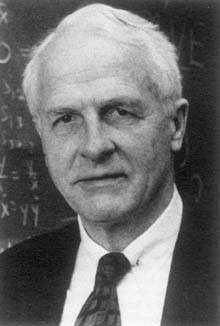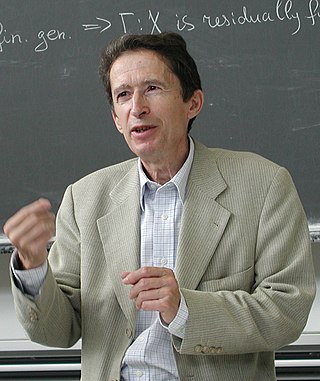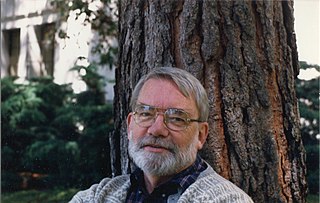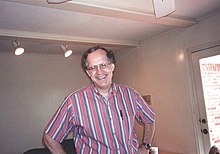
Jean-Pierre Serre is a French mathematician who has made contributions to algebraic topology, algebraic geometry and algebraic number theory. He was awarded the Fields Medal in 1954, the Wolf Prize in 2000 and the inaugural Abel Prize in 2003.
In functional analysis, a discipline within mathematics, given a C*-algebra A, the Gelfand–Naimark–Segal construction establishes a correspondence between cyclic *-representations of A and certain linear functionals on A. The correspondence is shown by an explicit construction of the *-representation from the state. It is named for Israel Gelfand, Mark Naimark, and Irving Segal.

Israel Moiseevich Gelfand, also written Israïl Moyseyovich Gel'fand, or Izrail M. Gelfand was a prominent Soviet-American mathematician. He made significant contributions to many branches of mathematics, including group theory, representation theory and functional analysis. The recipient of many awards, including the Order of Lenin and the first Wolf Prize, he was a Foreign Fellow of the Royal Society and professor at Moscow State University and, after immigrating to the United States shortly before his 76th birthday, at Rutgers University. Gelfand is also a 1994 MacArthur Fellow.

Armand Borel was a Swiss mathematician, born in La Chaux-de-Fonds, and was a permanent professor at the Institute for Advanced Study in Princeton, New Jersey, United States from 1957 to 1993. He worked in algebraic topology, in the theory of Lie groups, and was one of the creators of the contemporary theory of linear algebraic groups.

Richard Dagobert Brauer was a leading German and American mathematician. He worked mainly in abstract algebra, but made important contributions to number theory. He was the founder of modular representation theory.

Kunihiko Kodaira was a Japanese mathematician known for distinguished work in algebraic geometry and the theory of complex manifolds, and as the founder of the Japanese school of algebraic geometers. He was awarded a Fields Medal in 1954, being the first Japanese national to receive this honour.

George Whitelaw Mackey was an American mathematician known for his contributions to quantum logic, representation theory, and noncommutative geometry.

Garrett Birkhoff was an American mathematician. He is best known for his work in lattice theory.

Bertram Kostant was an American mathematician who worked in representation theory, differential geometry, and mathematical physics.

Phillip Augustus Griffiths IV is an American mathematician, known for his work in the field of geometry, and in particular for the complex manifold approach to algebraic geometry. He is a major developer in particular of the theory of variation of Hodge structure in Hodge theory and moduli theory, which forms part of transcendental algebraic geometry and which also touches upon major and distant areas of differential geometry. He also worked on partial differential equations, coauthored with Shiing-Shen Chern, Robert Bryant and Robert Gardner on Exterior Differential Systems.
The mathematician Irving Kaplansky is notable for proposing numerous conjectures in several branches of mathematics, including a list of ten conjectures on Hopf algebras. They are usually known as Kaplansky's conjectures.
Victor Gershevich (Grigorievich) Kac is a Soviet and American mathematician at MIT, known for his work in representation theory. He co-discovered Kac–Moody algebras, and used the Weyl–Kac character formula for them to reprove the Macdonald identities. He classified the finite-dimensional simple Lie superalgebras, and found the Kac determinant formula for the Virasoro algebra. He is also known for the Kac–Weisfeiler conjectures with Boris Weisfeiler.
In mathematics, the Langlands classification is a description of the irreducible representations of a reductive Lie group G, suggested by Robert Langlands (1973). There are two slightly different versions of the Langlands classification. One of these describes the irreducible admissible (g, K)-modules, for g a Lie algebra of a reductive Lie group G, with maximal compact subgroup K, in terms of tempered representations of smaller groups. The tempered representations were in turn classified by Anthony Knapp and Gregg Zuckerman. The other version of the Langlands classification divides the irreducible representations into L-packets, and classifies the L-packets in terms of certain homomorphisms of the Weil group of R or C into the Langlands dual group.

Ernest Borisovich Vinberg was a Soviet and Russian mathematician, who worked on Lie groups and algebraic groups, discrete subgroups of Lie groups, invariant theory, and representation theory. He introduced Vinberg's algorithm and the Koecher–Vinberg theorem.

Gilles I. Pisier is a professor of mathematics at the Pierre and Marie Curie University and a distinguished professor and A.G. and M.E. Owen Chair of Mathematics at the Texas A&M University. He is known for his contributions to several fields of mathematics, including functional analysis, probability theory, harmonic analysis, and operator theory. He has also made fundamental contributions to the theory of C*-algebras. Gilles is the younger brother of French actress Marie-France Pisier.

Jens Carsten Jantzen is a German mathematician and professor emeritus at Aarhus University working on representation theory and algebraic groups. He introduced the Jantzen filtration and translation functors.

Georgia McClure Benkart was an American mathematician who was known for her work in the structure and representation theory of Lie algebras and related algebraic structures. She published over 130 journal articles and co-authored three American Mathematical Society memoirs in four broad categories: modular Lie algebras; combinatorics of Lie algebra representations; graded algebras and superalgebras; and quantum groups and related structures.

Mara Dicle Neusel was a mathematician, author, teacher and an advocate for women in mathematics. The focus of her mathematical work was on invariant theory, which can be briefly described as the study of group actions and their fixed points.

William George Bade was an American mathematician, who did his most significant work on Banach algebras.
James Michael Gardner Fell was a Canadian-American mathematician, specializing in functional analysis and representation theory. He is known for Fell bundles. He was an accomplished linguist who knew Sanskrit, Icelandic, German, French, Russian, Greek, and Latin.















